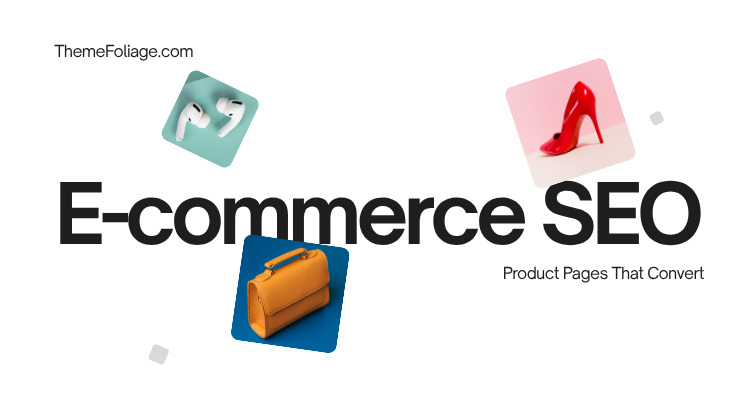Product pages are where search intent meets conversion. For e-commerce sites, they are the pages that must do two things exceptionally well: rank in search results and convert visitors into buyers.
This guide explains how to build product pages that satisfy both search engines and customers, covering titles, descriptions, images, structured data, technical hygiene and conversion optimisation.
Why product pages deserve dedicated SEO
Product pages target high-value transactional intent. A well-optimised product page can deliver sustained organic revenue, not just traffic.
- They capture purchase intent: users on product pages are usually further along the funnel.
- They influence revenue directly, so small gains can have large business impact.
- Search features (shopping results, rich snippets) can increase CTR and visibility.
Core elements of a converting product page
Every product page should include the following elements, each optimised for SEO and conversion.
- Optimised title tag and meta description.
- Clear, single H1 that matches the user intent.
- Persuasive, unique product description.
- High-quality images with srcset and descriptive alt text.
- Price and availability information, visible to bots and users.
- Structured data (Product schema, AggregateRating, Offer).
- User reviews and UGC (user-generated content).
- Relevant internal links (related products, category, care pages).
- Fast load times and mobile-first design.
- Trust signals: returns policy, secure checkout, shipping info.
Title tags & meta descriptions: the CTR levers
Title tags and meta descriptions are your primary CTR optimisation points in the SERP. Write them for relevance and persuasion.
- Title tag: include brand/product model and one strong keyword variant. Keep it readable and avoid stuffing — aim for 50–60 characters.
- Meta description: communicate value: price, key benefit, urgency or shipping info. Keep it around 120–155 characters.
- For large catalogues, use templates with variable insertion (brand, model, size) but test a sample set to avoid repetitiveness.
Crafting product descriptions that rank and convert
Product descriptions must be unique, informative and aligned with buyer intent. Avoid manufacturer copy where possible.
- Lead with the benefit: explain what the product does for the user within the first 50–100 words.
- Include specifications: dimensions, weight, material, compatibility, provided clearly (tables are good).
- Use persuasive language: highlight key features and expected outcomes, but avoid hyperbole that could mislead.
- SEO-friendly length: aim for 300–800 words, depending on complexity, more for high-value or technical products.
- Include keyword variants: use semantic variations and long-tail phrases naturally (e.g., “waterproof running shoes for men”).
Images, video and media: visual persuasion + performance
High-quality media increases conversion but can harm performance if not optimised.
- Multiple images: show product from different angles, in context and with close-ups for detail.
- Responsive images: use
srcsetand sizes to serve appropriate file sizes for devices. - Modern formats: serve WebP or AVIF where supported, with fallbacks for older browsers.
- Lazy load: defer off-screen images to improve LCP.
- Descriptive alt text: explain the image for accessibility and add subtle keyword relevance where natural.
- Video: short demo videos or 360° views can boost conversions and dwell time; provide transcripts where relevant.
Structured data: product, offer and reviews
Structured data increases the chance of rich snippets and clearer indexing. Implement JSON-LD Product schema and related subtypes.
- Product: name, description, brand, SKU, mpn.
- Offer: price, currency (USD), priceValidUntil, availability, url.
- AggregateRating: ratingValue, reviewCount — ensure values reflect real reviews.
- Review: include author, datePublished and reviewBody when available.
- Always keep schema accurate — do not markup information that is not visible on the page.
- Validate with Google’s Rich Results Test and monitor enhancements in Search Console.
Reviews, UGC and trust signals
User reviews are both an SEO asset and a conversion signal. They add fresh content and social proof.
- Encourage verified purchases to leave reviews; mark them as such in your system.
- Implement review schema for each review and an aggregate rating for the product.
- Moderate for spam but avoid over-filtering genuine critiques, balanced reviews build trust.
- Show return policy, secure checkout badges and delivery estimates prominently.
Internal linking & category hierarchy
Internal linking helps distribute authority and assists users to discover related products.
- Link back to parent category and to complementary or alternative products.
- Use descriptive anchor text that signals topical relevance (e.g. “matching spare battery”).
- Ensure product pages are reachable within three clicks from the homepage where possible.
- Consider breadcrumb schema to improve navigation and SERP display.
Faceted navigation, canonicals and pagination
Facets and filters create many URL permutations that can dilute index signals if not managed.
- Where filters create unique, useful content (e.g. size + colour combinations), allow indexing selectively; otherwise use
noindex, followor block via robots for low-value patterns. - Use canonical tags for similar product variations, pointing to the preferred canonical page.
- For paginated lists, implement rel=”next/prev” where appropriate and ensure each product page has its own canonical.
Page speed and Core Web Vitals
Performance matters: slow product pages reduce conversions and can harm ranking. Prioritise LCP and interaction readiness.
- Optimise hero image delivery for LCP, preload the main image and make it responsive.
- Defer non-critical JavaScript (third-party widgets can be costly).
- Use a CDN for global delivery and compress images and assets.
- Measure field data via CrUX and Search Console; use lab tools (Lighthouse, WebPageTest) for debugging.
Conversion optimisation (CRO) considerations
SEO brings visitors; CRO turns them into buyers. Design product pages that remove friction.
- Clear, prominent call to action: “Add to basket” or “Buy now”.
- Price clarity: show price, discounts, VAT info and shipping cost estimates early.
- Stock information: “In stock”, “Low stock” or “Out of stock” messaging helps urgency and expectation setting.
- Fast checkout: reduce form fields, offer guest checkout and multiple payment options.
- Cross-sell and upsell blocks should assist rather than distract from purchase.
International considerations
If you sell to multiple markets, handle localisation carefully.
- Use hreflang for country or language variants to avoid duplicate content issues.
- Serve localised currency and shipping information; display price in USD where required, but also support local currencies if possible.
- Local laws and VAT can affect pricing display, be transparent to build trust.
Measuring success: KPIs and experiments
Track both SEO and business KPIs to evaluate improvements.
- SEO KPIs: organic impressions, clicks, average position, rich result appearances.
- Business KPIs: sessions, add-to-cart rate, conversion rate, average order value (AOV) and revenue per visitor.
- Run A/B tests for title tags, page layouts, image sizes or CTA wording to find uplifts in CTR and conversion.
- Use holdout pages or geo splits for large experiments to control bias.
Common mistakes and how to avoid them
- Duplicate content from manufacturer descriptions, always add unique content.
- Indexing thousands of thin variants, manage faceted nav and canonicalisation.
- Overuse of third-party scripts (review widgets, chat) that slow pages; move to async or deferred loading.
- Ignoring mobile UX, test every checkout flow on real devices.
- Inaccurate schema, ensures data in JSON-LD matches page content and prices.
Practical product page template (copyable)
Use this template to standardise product pages across your catalogue.
H1: [Product name — Brand/Model]
Hero section:
- Main image (responsive)
- Price + Offer badge (if applicable)
- Add to basket CTA
- Short 1–2 line benefit statement
Summary / Bullets:
- Key features in 3–6 bullets
- Primary specification (dimensions, weight, material)
Detailed description:
- 300–800 words covering use cases, benefits and technical specifics
- Specification table for dimensions and compatibility
Social proof:
- Aggregate rating + snippets of recent reviews (with review schema)
Logistics:
- Shipping estimate, returns policy, warranty details
Related:
- Complementary products, alternatives and category links
Technical:
- JSON-LD Product + Offer + AggregateRating
- Canonical tag
- Breadcrumb schema
Checklist before publishing a product page
- Unique title and meta description written and validated.
- H1 matches title intent and is visible on page.
- Product description unique, factual and complete.
- Images optimised, alt text present and srcset configured.
- Product schema correctly implemented and validated.
- Price, availability and shipping info present and machine-readable.
- Internal links to category and related items included.
- Page speed checks passed for target markets.
- Reviews enabled and moderated workflow defined.
Conclusion
E-commerce product pages are the linchpin of online retail performance. Good SEO alone is not enough, product pages must balance discoverability and conversion.
Apply the templates and checks in this guide, validate structured data, keep media efficient and test changes thoughtfully.
With disciplined execution, product pages will both climb the SERPs and convert visitors into customers. Also check out – AI for Local SEO.



